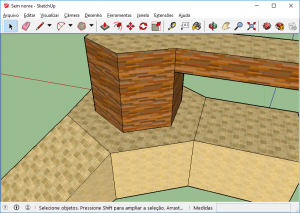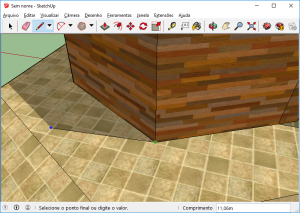Shadows
This page is a part of the Custom Track Tutorial and should describe how to create shadows in your custom track's model, for a more realistic and professional looking track.
Using Shadow Mapping
This is the method Nintendo uses on the original tracks. You might have noticed, if you examined a Nintendo track BRRES on any editor, that there is a texture similar to a 3D model which many tracks use. This is a secondary texture that is applied on top of the model, in a secondary UV channel, to create the image of shadows.
Using Darker Textures
This is a less efficient, but easier way of creating shadows in your track. In Sketchup, activate the display of shadows and edit it in Sketchup's shadow dialog (the shadows generated here will not be exported as either OBJ or DAE) and then divide your model into smaller parts using the shadows as a base, as shown in the images. Texture the shadowed areas with a darker texture and then import it.
Also, in the collision model, you can make the shadowed areas have a different KCL flag for a different post-effect lightning to be used on top of the player when you're under the shadow.
The disadvantages of this method are the difficulty of doing this on more complex models; the higher file size and higher chance of creating a Slow Motion Bug due to more textures and polygons. Shadow maps also makes shadows more realistic.
Main Tutorials
Introduction –
Textures –
Scale –
Modeling ⇒ Using Blender –
BRRES: CTools
BRRES: BrawlBox –
BRRES: RiiStudio –
Minimap –
Solidity –
KCL: Wiimms Tools –
KMP Editing
Object Editing –
Cameras –
Cannons –
Post-effects –
Videos
Battle Arenas
Battle Arenas –
Enemy routes in battle arenas ⇒ Using Wiimm's Tools –
Coins
Misc. Tutorials
Getting Files –
BrawlBox Tricks –
Animations –
Shadows –
Mipmaps
Custom Effects –
Moving Terrain –
Music –
Ports –
Paint Remakes –
Tutorial Archive
Extended presence flags: Track Tutorial –
LE-CODE Track FAQ
Testing and Reviewing
Testing a Track –
Visual Review –
Track Transformation –
Fixing Errors
Software
3D Tools –
BrawlBox –
CTools Pack –
KMP3D –
KMP Cloud –
KMP Modifier
Lorenzi's KMP Editor –
MagicY –
Material Tool –
Post-Effect Editor –
Wiimms SZS Tools –
Wiimm's Tool Manager
Other
KMP Objects –
Custom Objects –
Model Database –
Tutorial Archive

